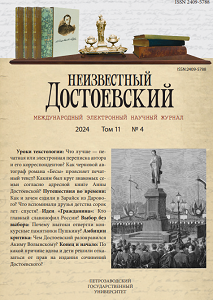Кто памятник воздвиг поэту? Пушкинский конкурс в обзорах «Гражданина» (1872–1874)
Who Erected the Monument to the Poet? Pushkin Competition in Reviews of “Grazhdanin” (“The Citizen”) for 1872–1874
Author(s): Olga Vladimirovna ZakharovaSubject(s): Cultural history, Museology & Heritage Studies, Russian Literature, 19th Century, Sociology of Literature
Published by: Петрозаводский государственный университет
Keywords: Pushkin; monument; sculpture; exhibition; Grazhdanin; The Citizen; F. M. Dostoevsky; art criticism; memory;
Summary/Abstract: In his reflections on death, A. S. Pushkin did not appreciate man-made monuments and copper idols, he was inspired by the idea of a “non-man-made” monument that would be eternal, resurrecting time and time again in every reader’s soul. The first man-made monument to Pushkin was the well-known tombstone monument in the necropolis of the Svyatogorsk Monastery (1841). In the 1850s and 1860s, there were constant public pleas to erect a national monument to the poet in Russia. In the course of the discussion, the site near the Holy Monastery in Moscow was chosen for the moment. The veneration of the poet’s memory and the discussion of the projects of his monument were reflected in the pages of the weekly “The Citizen,” edited by F. Dostoevsky. In April 1873, two reviews of the first exhibition of Pushkin monument models were published in the weekly. 15 projects were submitted for the competition. The authors of the published articles presented a critical analysis of all the projects, noting their advantages and disadvantages. Critics were ruthless towards unsuccessful projects. They didn’t like boilerplate solutions. The models received a generally negative assessment. The review of the second exhibition of Pushkin’s monument projects, which was published in the 19th issue of The Citizen in 1874, ended with the same verdict. Both contests were actually a no-choice choice. It was only in the third competition in 1875 that the winner — A. Opekushin’s monument to Pushkin was determined, and it subsequently was opened on June 6, 1880. Reviews of models and their criticism constituted an important portion of the Pushkin-themed content of the weekly “The Citizen.” They not only characterized the media aspect of Pushkin’s reception in Russia, but also had great political and social significance. The citizens of Russia and the readers of “Citizen” collected people’s money for the construction of the monument. During the unveiling of the monument, ideas were expressed that still determine the future of Russia. The opinions of the authors of the articles and editors of The Citizen V. Meshchersky and F. Dostoevsky raised the status of polemics and ultimately contributed to the triumph of the Pushkin Holiday in 1880. This is how the concept of the holiday as a historical event and the concept of Pushkin as a poet, prophet and “vsechelovek” (“panhuman”) developed.
Journal: Неизвестный Достоевский
- Issue Year: 11/2024
- Issue No: 4
- Page Range: 274-297
- Page Count: 24
- Language: Russian

